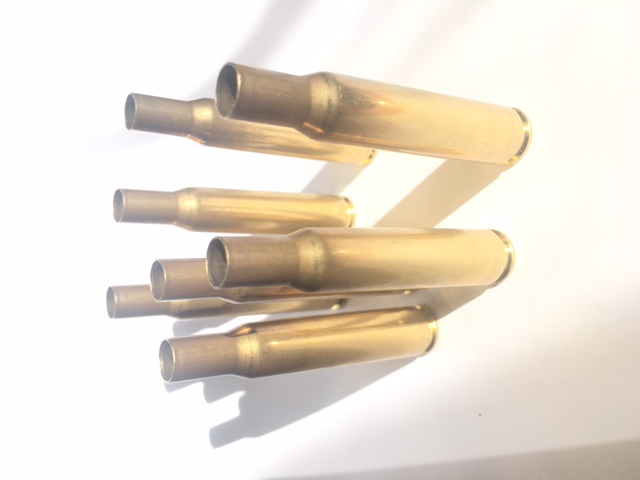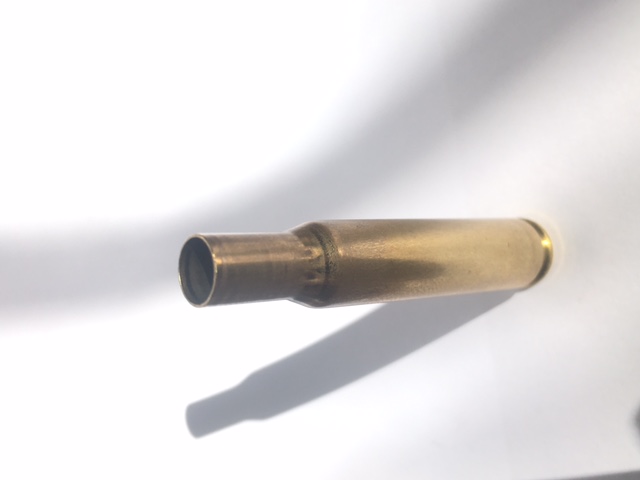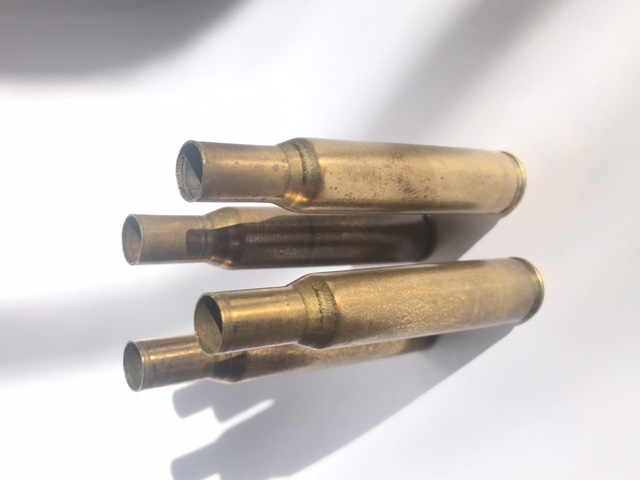Brass Forming the 7x60
The idea of forming .30-06 or one of the various cartridges of similar dimension appeared in my imagination as a straightforward process. However, initial attempts were anything but. I began with trial and error of adjusting my Redding 7x57 FL sizing die, working my way through a pile of sacrificial .30-06 cases until I could chamber them in the Parker Hale with a slight felt pressure on the bolt handle. During this process I used the usual light smear of Redding sizing wax on the inside neck and outside of the case to ensure smooth die operation, and noticing with trepidation that every case was suffering from the ‘neck crumpling’ or ‘dimpling’ effect that was occurring as the .30-06 shoulder was reformed into the neck of the 7x60.
The next step was to experiment with forming clean brass and figuring out how to avoid the constant crumpling effect. My range of brass included; New Norma 25-06, new Lapua .30-06, once fired Norma 7x64 and a range of well used .30-06, including Norma, Sako, S&W and Winchester.
I had purchased over 100 pieces of the 7x64 Brenneke believing they would form well enough, but would be the most appropriate headstamp, that I could probably modify with a small punch to 7x6•
What I failed to take into account with the Brenneke was that the base diameter is .466, not .471 of the .30-06, which is already smaller than the .472 of the 7x57, which is what the 7x60 reamer is based off. I had mentioned that this was my intention during the design of the reamer, and Mr.Gross did not believe this would be an issue, so I will continue to test the 7x64 brass alongside everything else.
After an evening of brass forming experiments, failures and successes, my results are thus:
Lubrication; It makes the most difference. I started out with the barest minimum of Redding sizing wax on my fingers in the same manner as the way I always size my cases under regular circumstances. Eight or nine times out of ten, no matter which brass was tested, it would result in damaged crumpled necks. At first I did not think it could be ‘over lubed’ as it was no more than a ‘sweaty thumbs worth’, but after wiping the cases my sleeve until it seemed they were dry, I could produce clean shouldered brass. They still needed plenty inside to avoid the jarring on the sizing button though.
Technique; I began by trying multiple passes, partly sizing the case and then backing out. Going in a little further, and so on, until I had worked the press handle to its fullest extent. Once I discovered the correct lube amount, I also found that one single smooth and slow pass of the brass into the die, the right amount of pressure, was all that was needed.
Brass age; It makes no significant difference. I was equally able to damage or dimple either new brass, once fired, or well used brass equally well as each other. Any of this brass was also equally able to form good clean, dimple free shoulders once correct lubing and technique was used.
Calibre of parent case; It matters. 7x64 and 25-06 always results in non-uniform, unattractive stepped necks. The .30-06 cases however, no matter which ones, produced uniformly smooth necks and shoulders.
Summary:
Regular lube inside the case neck, with almost none on the outside.
Size the brass in one pass not multiple.
Brand and age of brass makes no difference to uniformity of results.
.30-06 cases produce reliable neck uniformity than other calibres, regardless of headstamp or age of brass.
During load development, I will load and fire a few cases that have minimal dimpling around the neck and shoulders and the cases with stepped necks, only out of curiosity to see what - if any - the effects of fire-forming will have on these cases. It is unlikely that fire-forming will smooth these pieces in any significant way so they will be disposed of after one use. I acknowledge that it is possible with inside neck reaming and outside neck turning that these cases could be used successfully; however there does not seem to be a reason to pursue this extra effort when the .30-06 brass has already produced perfectly shaped cases that should not need turning or reaming.
Formed cases awaiting trimming.
Perfectly formed Lapua .30-06 brass into 7x60
Attachment 229328
Early failures : New Lapua .30-06 with crumpled neck due to incorrect lubing and technique
Attachment 229331
Ugly necks, 7x64 on the left, 25-06 on the right.
Attachment 229329
Good looking .30-06 parent cases formed into 7x60. Brass of various headstamps and age.
Attachment 229330
Brass Trimming
Without a machine suitable for taking 2-3mm off a piece of brass in an easy repeatable process, I deferred to my mad-max tech. This consists of clamping an angle grinder and 1mm cut off wheel in the vice, and positioning a battery drill at right angles to the cut off wheel, with a guide rail clamped to the workbench at the back of the drill to retain a consistent cut length. Numerous experiments with using an angle grinder and cut-off disc revealed that the best way to get uniform brass cutting was to allow the grinder to cut only one side of the brass while it rotated in the chuck of a drill, as opposed to cutting right through the brass without rotation. Anyone whos ever tried to cut a tube perfectly without a drop saw will attest to the difficulty of getting a perfect cut. One day I will just get a small drop saw…
Welcome guest, is this your first visit? Create Account now to join.
Welcome to the NZ Hunting and Shooting Forums.
Search Forums
User Tag List
Results 1 to 15 of 37
Thread: my 7x60 wildcat project
Threaded View
-
20-07-2023, 08:25 PM #2
Last edited by -BW-; 20-07-2023 at 08:34 PM.
Similar Threads
-
Attempting a new .224 wildcat
By Wingman in forum Reloading and BallisticsReplies: 46Last Post: 26-06-2023, 09:56 PM -
Wildcat/brassforming/fun project question
By Tuckerbox in forum Reloading and BallisticsReplies: 3Last Post: 30-08-2017, 01:05 PM -
My new wildcat round
By Maca49 in forum Reloading and BallisticsReplies: 11Last Post: 12-06-2014, 12:13 PM -
30Apache (30-223 wildcat)
By kimjon in forum Reloading and BallisticsReplies: 13Last Post: 01-02-2013, 09:59 AM
Tags for this Thread
Welcome to NZ Hunting and Shooting Forums! We see you're new here, or arn't logged in. Create an account, and Login for full access including our FREE BUY and SELL section Register NOW!!




 38Likes
38Likes LinkBack URL
LinkBack URL About LinkBacks
About LinkBacks








 Reply With Quote
Reply With Quote


Bookmarks